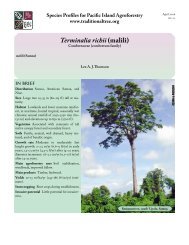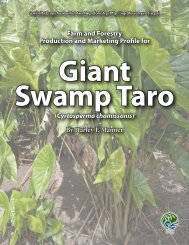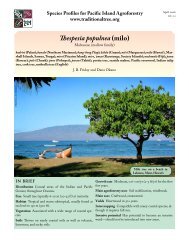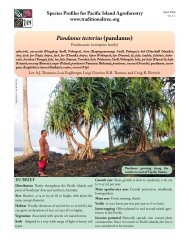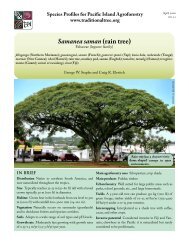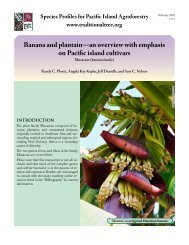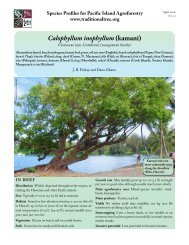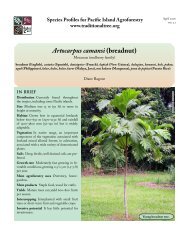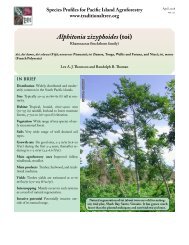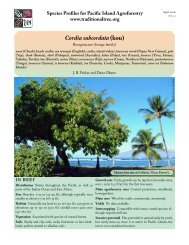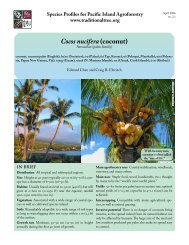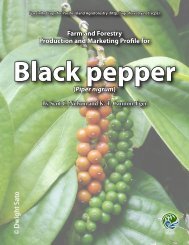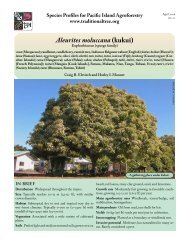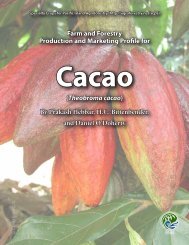Rhizophora apiculata, R. mucronata, R. stylosa, R ... - Agroforestry Net
Rhizophora apiculata, R. mucronata, R. stylosa, R ... - Agroforestry Net
Rhizophora apiculata, R. mucronata, R. stylosa, R ... - Agroforestry Net
You also want an ePaper? Increase the reach of your titles
YUMPU automatically turns print PDFs into web optimized ePapers that Google loves.
Tannin/dye<br />
The bark and hypocotyls are used to produce dyes ranging<br />
from red-brown to black (the latter with repeated dying).<br />
<strong>Rhizophora</strong> species are the best producers of tannins of all<br />
the mangroves with 20–25% of bark weight (Percival and<br />
Womersley 1975). Chopped bark is treated by continuous<br />
countercurrent extraction with first cold then warm water<br />
producing an extract called “cutch.” The cutch can be<br />
exported for processing and final tannin extraction. Tannins<br />
were used extensively for preserving cotton ropes and<br />
netting. Mangrove tannins can be used to prepare tannin<br />
formaldehyde adhesives. These adhesives are recognized<br />
for their high moisture resistance and waterproof grades in<br />
plywood and particleboard production. <strong>Rhizophora</strong> tannins<br />
are also known to impart a red color to finished leather<br />
tanning, but this is considered undesirable since blending<br />
with other tannin extracts is needed.<br />
Ecotourism<br />
The mangrove environment is attractive and interesting<br />
to both local people and to visiting tourists. In China, for<br />
example, facilities have been provided to assist and regulate<br />
this form of ecotourism, including a dedicated hotel<br />
and restaurants. Simple boardwalks in other places (e.g.,<br />
Australia, Thailand) are relatively low key but the intention<br />
is the same, to provide public access for those wanting<br />
to see and learn about this fascinating environment. The<br />
boardwalks are there to make the mangrove experience as<br />
effortless as possible while protecting the mangroves from<br />
direct damage. Walks are often also accompanied with informative<br />
and educational signage.<br />
COMMERCIAL CULTIVATION<br />
Stilt mangrove timber is harvested commercially for charcoal<br />
production in SE Asia. The calorific value of the timber<br />
is significantly enhanced by converting it to charcoal.<br />
This is done with various <strong>Rhizophora</strong> species. Charcoal<br />
production has been conducted in a sustainable way on<br />
the Malay Peninsula for over 100 years using silvicultural<br />
practices developed for <strong>Rhizophora</strong> species, especially R.<br />
<strong>apiculata</strong> (Ong et al. 1980, 1995). In addition, forests in Malaysia,<br />
New Guinea, and the Solomon Islands have been<br />
clear-felled for wood chips using unsustainable harvesting<br />
practices.<br />
Spacing<br />
Mangrove plantations in general are typically planted at<br />
spacings of about 1.0–1.5 m (3.3–5 ft). Spacing wider than<br />
about 2.5 m (8 ft) tends to result in a high proportion of<br />
multiple-stemmed and/or shorter trees. Wider spacing<br />
1 Indo–West Pacific <strong>Rhizophora</strong> species<br />
Eleven-year-old plantation of <strong>Rhizophora</strong> <strong>apiculata</strong> in the<br />
63 ha (156 ac) Bakhawan Eco Park at Kalibo, northern Panay,<br />
Philippines. photo: N. C. Duke<br />
and the resulting spreading trees may be desired for coastal<br />
protection projects, but not for timber production. In the<br />
absence of significant natural mortality timber plantations<br />
should be thinned to spacing of 2.5 to 3.5 m (8–11 ft) between<br />
trees as the stand develops and becomes crowded.<br />
Management objectives<br />
In areas where the mangrove fern (Acrostichum speciosum)<br />
is common, it may need to be controlled to promote early<br />
growth of stilt mangroves. Some published guidelines for<br />
mangrove silviculture exist and are referenced below, but<br />
specific guidelines on thinning, fertilizing, etc., are currently<br />
unavailable.<br />
Growing in polycultures<br />
Stilt mangroves naturally occur in mixed-species stands,<br />
and each species has its own ecological and economic values.<br />
Mixed-species plantings are recommended together<br />
with large-leaf mangrove, Bruguiera gymnorrhiza. It is also



